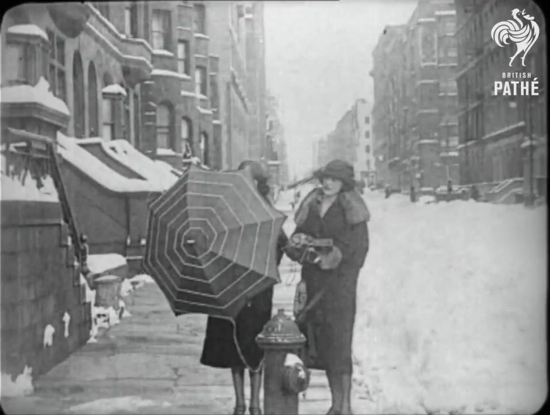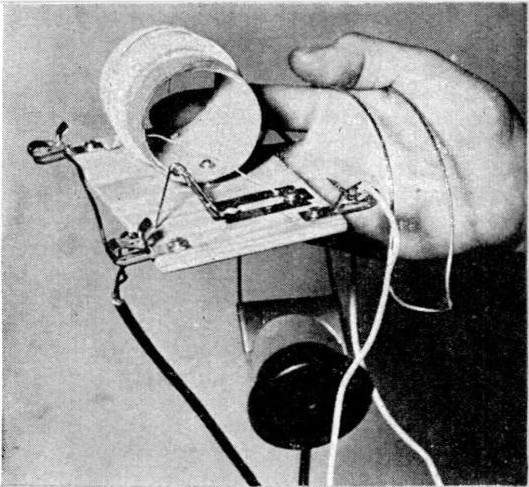
While attempts at radio-like transmissions began in the 1830 Guglielmo Marconi successfully transmitted and received what would come to be called radio in 1894.
The above picture is a type of crystal radio two-way transceiver that acted like a cell phone.
Tags:
Replies to This Discussion
-
Permalink Reply by The Specialist on May 5, 2017 at 10:02pm
-
Let's not forget Alexander Graham Bell's Photophone. It was a device that used modulated light pulses to transmit voice from one place to another, wirelessly. It was proven to be difficult to eavesdrop on, unlike radio, and it was limited to line of sight, although amplifier stations had been considered for urban locales.
-
-
Permalink Reply by Captain on May 8, 2017 at 12:01pm
-
KDKA Radio (AM) in Pittsburgh, PA was the pioneer radio station first broadcasting 11/2/1920.

-
-
Permalink Reply by Captain on December 27, 2020 at 1:44pm
-
Still on the air after 100 years. https://www.radio.com/kdkaradio/topic/kdka-radio
-
-
Permalink Reply by Captain on May 8, 2017 at 5:09pm
-
The rectifying properties of crystals was discovered in 1874 with the first patent for a crystal radio be filed in 1901 then granted in 1904. Early crystal radios had their opposite, the spark gap transmitter, to listen to until 1920 when the first radio station began broadcasting. History
Crystal radio require no power except the radio wave itself so they need very long wire antennae. This is one clever work around:

-
-
Permalink Reply by Captain on May 18, 2017 at 7:01pm
-
A DieselPunk cousin to the crystal radio was the "foxhole radio" Foxhole Radio

Very basically it substitutes a rusty old style carbon steel razor blade for the crystal for tuning.
These brilliant examples of Yankee ingenuity not only allowed WW II soldiers living in very crude conditions access to radio but defeated the Axis receiver tracking technology since, like a crystal radio, it produces no power to home in on.
-
-
Permalink Reply by Captain on August 2, 2017 at 4:58pm
-
Spark Gap Transmitter (1842)

"The effects of sparks causing unexplained "action at a distance", such as inducing sparks in nearby devices, had been noticed by scientists and experimenters well before the invention of radio." These electric sparks emit a wide burst of RF energy as well which can be picked up by most radios. This early device allowed for Morse code messages.

-
-
Permalink Reply by P. Aloysius Regnad on September 4, 2017 at 5:25pm
-
The spark gap transmitter is basically a radio frequency broadband noise generator, that includes a tuned circuit (made from what would probably have been called a coil, and condenser, back then) to try and select out a single frequency. It beat nothing, but not by much. Putting such a device on the air today will get you a hefty fine.
The Rotary Spark Gap was a bit of an improvement. At least it was more efficient. The idea was to spin some contacts around (using some kind of motor), and get lots of separate sparks whose energies could be combined. This led to the timed, or synchronous, spark gap, which could be tuned, more or less, to a desired frequency. Timed spark eventually evolved to a point where it rivaled the signal quality of a transmitting alternator, but I think alternators, and the people involved with their development, deserve a discussion of their own.
-
-
Permalink Reply by P. Aloysius Regnad on September 4, 2017 at 6:55pm
-
The crystal radio is one of the oldest, and simplest forms of receiver. It has very few components, and (here's the good part) can still be used today to receive signals in the AM Broadcast Band!
https://www.midnightscience.net/
Is a good place to get familiar with the concepts. They even have some free plans, and if you can't find the parts, they have those too, as well as complete kits. They used to have more, but... Oh well.
There's also
http://www.peeblesoriginals.com/index.php
Kits, cat's whisker detectors, and more.
Another site...
It looks like it hasn't been updated in ages, but has plenty of info.
I'll toss out a few tips, in case anyone's interested.
1) You really need the "crystal earphone", or some other type of high impedance listening transducer. Earphones for modern electronic devices are low impedance, and will offer poor results, if they work at all.
2) A good ground is a must! This can be a metal (not PVC) cold water pipe, or a metal rod driven as far into the ground as possible. (If you live near a body of water (swimming pools don't count) you can toss your ground wire into it. Just be sure it sinks.) The "safety ground" (third prong) found on electrical outlets shouldn't be used. It can work, but can also introduce noise, and if there's a fault in the wiring, using it could be hazardous!
3) For the antenna, the oldest rule still works best. Get as much wire as high into the air as possible.
4) The detector (or crystal, from which the receiver gets its name) is very important. It has to perform the electrical function of rectification, and still show as low a resistance, or forward voltage drop, as possible. The standard fallback is the 1N34 germanium diode, but there are "hotter" diodes around, if you can find them. And one can always build, or buy, a genuine "cat's whisker" mineral detector. (If you're an experienced experimenter, you could try using an Electrolytic Detector, also called a "Liquid Barretter", but these use acids, so care must be taken.)
You really can still hear radio broadcasters with a crystal set, especially after sundown. I have several, although I haven't used them in a long time.
-
-
Permalink Reply by P. Aloysius Regnad on December 27, 2020 at 12:54pm
-
The other day I was going through my old crystal radio bookmarks, and I'm afraid I must report that Peebles is no longer selling kits. The site says there are plans for them to become available from another source, but as of right now, that hasn't happened.
What got me to do this was trying to find a source for a super low forward voltage drop rectifier. There used to be such devices, and I even had a few, but they're gone now, I don't remember the part number, and they're almost certainly no longer being produced anyway. I do have some info for using a little IC as a detector, and a few of the devices, but that's all still in storage, so I can't be more specific. I never got around to building one of the sets, but the author of the article indicated that the circuit would even work for the lower short wave bands. (Up to as high as 7.5 megacycles.) That's why I was interested in that design, although right now, international short wave broadcasting has been virtually abandoned. There are still a few stations around, but they're mostly just propaganda outlets, like Radio Havana Cuba. There are other transmissions out there, but most of them are CW (continuous wave Morse code telegraphy), SSB (single side band), or various digital modes, none of which can be demodulated by a simple crystal set.
So the old AM broadcast band is about it. I'm afraid that makes the crystal radio just a cute bit of simple technology now. It still works, but there's not much of interest to hear with it, as I see things.
-
-
Permalink Reply by Captain on December 27, 2020 at 1:59pm
-
There are several new and vintage crystal radio kits for sale on Ebay including galena crystals. These might be even better for a modded SP project. There are also a number of AM transmitters for sale on Ebay. If I recall correctly, the FCC doesn't much care what you do under 5 watts(?) Since at least Abney Park (and possibly some other SP bands) have already given blanket permission to broadcast their music an enthusiastic amateur might run their own SP radio station.
-
© 2025 Created by Alexander Baker.
Powered by
![]()
